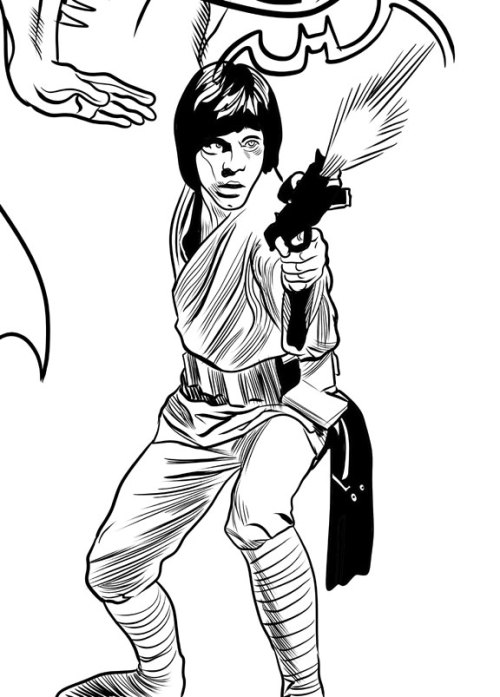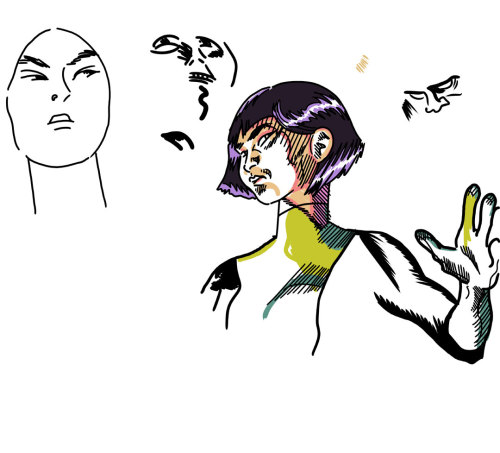Did you have that old
How to Draw Comics the Marvel Way book with all the examples from various Marvel comics and most especially from John Buscema? Stan Lee's text made drawing comics the Marvel way seem easy, a lark. Buscema's super-assured drawings and those from guys like Jack Kirby and Gene Colan told a different story. Still,
How to Draw Comics the Marvel Way is a nice introductory text on drawing comics with the necessary basics artists should still be using no matter how up-to-date their rendering style is. Take your funkiest, latest stylist and give him or her a solid grounding in fundamentals of figure construction, panel composition, storytelling and layout and you'd have the post-Image artist to steal my cold, shriveled heart.
As a member of a couple of fan pages for Buscema and Kirby frequented by actual comic book-making professionals in the industry, I get intermediate to advanced lessons in comic book drawing almost every single day. That-- and some encouragement along those lines-- has gotten me back into drawing in a major way. I spent my Golden Week holidays off from work drawing six or more hours a day, but even before then I was putting in at least two hours after work and more on weekends. Yesterday, I drew for about 8 hours without a break. Then, in my punchiness, I accidentally posted some of my crap to one of those fan pages. Luckily for me, the 12 hour time difference meant few, if any, saw it before I deleted it.
Very embarrassing.
Sometimes I wonder when I watch some amateur singing competition on TV is the participants have ever actually heard themselves sing. Yeah, some people can really belt a tune, but most of us are middling singers at best and some are downright tone-deaf and horrible. And yet they seem convinced their screeching is the equivalent of Whitney Houston's voice in its prime, or at least Beyoncé's. When I sing, I can hear that I'm sharp or flat or just can't reach that note. Apparently, some people cannot do this and so they audition for
American Idol and we get a viral video sensation on the Internet the next day.
I'm at the same level with my drawing that I am with my singing. I can look at a drawing after I've made it and know it's inadequate. I can even tell in what way it is. I do a lot of my inking in Adobe Illustrator because I can get a clean, slick look and make adjustments until it looks mostly like the amazing image I had in my mind when I set out to draw it. It never matches it exactly. My imagination is much more talented than my actual eyes and hand. But what I see is still amateur hour at best. The karaoke box crooner version of what I'd like it to be.
The other day, I saw a John Buscema drawing of a pirate. Just a single figure doing nothing more than standing there with a sword in his hand. Buscema had inked it himself, very heavily, too. Man, it put my best efforts to shame. If I make a drawing with 10,000 lines, 10 of them might be as good as a Buscema line but they're covered up by the Bryan lines that aren't where they're supposed to be or lack polish or energy or skill. Whatever it is Buscema had that I lack.
I'll be honest with you-- it was so good and made my art look so pathetic by comparison, I wanted to pull my teeth out. I didn't know what I wanted to do. Head back up river and pull a fade-away into the jungle again. Only the jungle looks like John Buscema drew it, or Al Williamson and that would just be too much to bear.
"But who is crazy enough to compare himself or herself to one of the greats like John Buscema?" you ask. "Few can ever achieve at that level. There are hugely popular and successful artists who don't even rate sharpening Big John's pencils. Why do that to yourself?"
It's not even the Buscema comparison. Because yeah, you're right-- doing that is completely insane. But think about the crappiest professional artist whose work you've ever seen in a printed comic book, and I am not even up to that level yet. Even Larry X. Lameartist doing a monthly job on
The Slipshod Costumedfools can draw circles around me.
This isn't false modesty or just some self-evisceration because I want people to feel sorry for me. I'm telling you the way it is. If I were a comic book editor and I saw work identical to what I'm doing now, I'd have to tell that hopeful exactly the same thing: "You are not ready for prime time." John Buscema drew the comic book adaptation of Stanley Kubrick's
Spartacus for Dell Comics before he lit up different books at Marvel and contributed his expertise to how to do it their way and even that Spartacus job-- as crude as it is compared to prime Buscema-- has that thing I don't see in my drawings.
It's frustrating. I'm not even aiming at that kind of pro career, to blow people away as the next John Buscema. Those kinds of dreams are for kids. I'd just love to do a job or two at some low level whatever, or get into the illustration game. Make a buck for myself, make a buck for someone else. But I wonder if I've wasted a lot of developing years. When I was a kid and I was almost as good as I am now, I felt satisfied and allowed myself to coast on raw talent. I should have been working as hard then as I am now, but I didn't understand the necessity. Someone-- I think it was Ken Griffey, Jr., said if you want to be a pro ballplayer (and this is true for any level of the game), you need to hit at least 500 balls a day. I should have been doing the art equivalent of that.
Instead, I bought the Porsche 911 with the quadrophonic Blaupunkt, topped in AA ball and made the
Sports Illustrated list of all-time draft busts.
Actually, I wish I had done even that much!
Well, regrets are for losers. I made my choices and they seemed like the way to go at the time. Looking back, if I was wrong, that's still hindsight speaking. All I can do is do what I can now. Draw as much as possible, study the greats and the not-so-greats, take advice from wherever I can get it and keep trying to make the next drawing better than the last. If nothing else, I've learned to have a huge amount of respect for even the lowliest, least loved line-maker working in comics, whoever that person may be.
Anyway, don't think when I post drawings here I have the feeling I'm blowing everyone away with my powerful stuff. I've got nothing to hide, no ego whatsoever when it comes to art these days. I like putting it out there as ugly or clumsy as it is. It may sound like I'm down on myself, but actually, my art amuses me. I do think it's kind of funny. And it's a kick knowing I'm putting these nutty images out there where they're living a life beyond whatever I intended for them.







